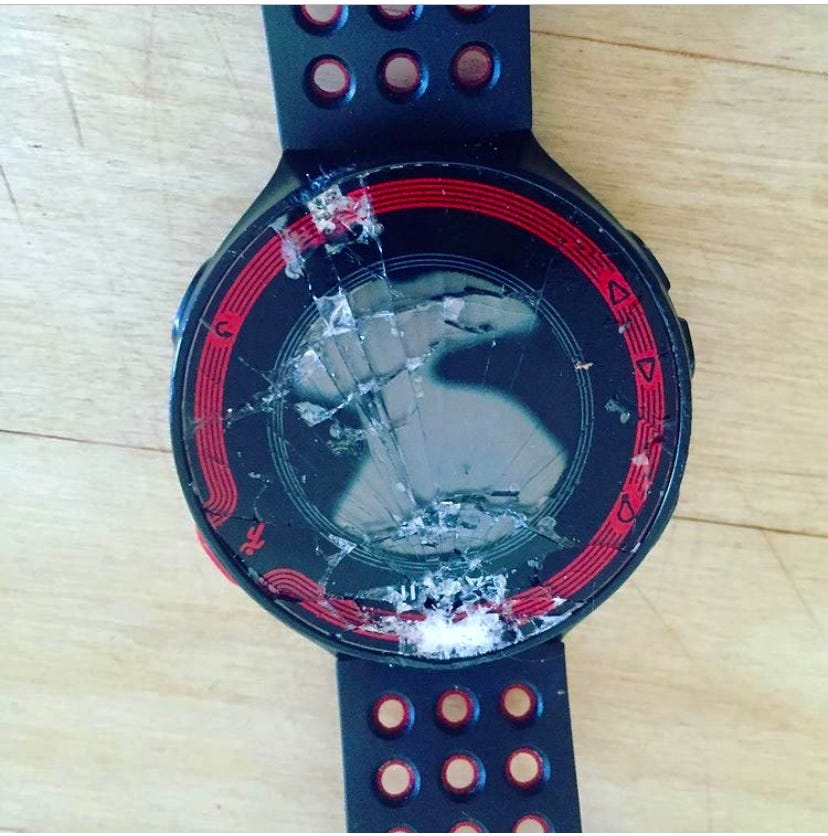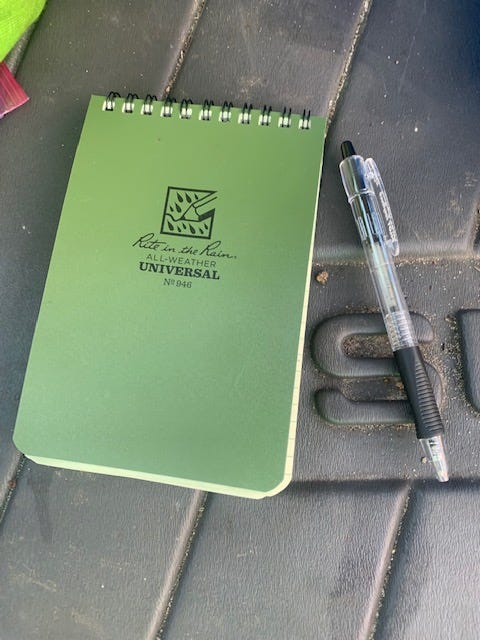I have a complicated relationship with my watch
My watch tells me all kinds of useful information, but does it really know me?
My first running watch was a Timex Ironman. I thought it was a magical machine, beeping like it did every mile with fresh information. It didn’t track climbing, cadence, or heart rate. It didn’t play music or answer the phone, because that would have been weird as hell in 1987.
There were no notifications or reminders to move every hour. The Ironman didn’t give me a thumbs up when I met my workout goals, nor did it shame me when I didn’t. In no way would anyone ever consider the Ironman, “smart.” It was just a tool to help me run better.
What the Ironman did give me was fine. It told me how far I had run, and how fast I ran each mile. There was also an interval function I could never quite figure out. Other than that, pace and distance was the extent of the information it conveyed. Due to the analog nature of the Ironman, I began tracking my workouts in a spiral notebook and maintain that practice to this day.
While I look back fondly at the simplicity of the Ironman, this is not an ode to nostalgia. In fact, I’ve upgraded my watch several times and have come to rely heavily on the amount of data today’s watches provide in training.
My first real running watch this century was a Garmin Forerunner, and I loved it. Each run generated all these numbers and data points, revealing themselves like secrets I never even knew existed. And, with its oversized face and sporty band, I really liked what the Forerunner said about me, an aspiring runner.
Alas, the Forerunner met its end when I tripped over a root and landed flush on a rock with my left wrist tucked under my chest. The watch absorbed much of the blow and may have helped save me from more serious damage. As it was, I wound up with bruised ribs and a swollen wrist, both of which felt awesome when I boarded a plane for Cleveland a few days later for the Eastern Conference finals.
(Incidentally, my doctor was sure I had broken the wrist. After X-rays came back negative she said, “I think your fitness saved you.” I’ve never heard a better compliment.)
Anyway, the Forerunner’s time came to an end right around the time I was thinking of upgrading to a more trail-running specific watch, mainly to track climbing -- vert in the vernacular. That led me to the COROS Pace that I use today.*
*I’d like to make it absolutely clear that whenever I mention gear in general and a brand specifically, it’s not an official endorsement in any way whatsoever. What works for me may not work for you.*
The Pace is the Subaru of trail running watches: reliable, durable, and affordable. That’s not a backhanded compliment. My actual Subaru has 15 years and counting on its odometer and I’m going to drive it for as long as possible. Like my Subaru, the Pace doesn’t have a lot of bells and whistles, but it has all the features I’m looking for in a trail running watch. Then again, that’s part of the appeal.
I’m a minimalist by nature when it comes to running. I don’t carry a phone or listen to music, and it’s not like I’m venturing into the back country where mapping technology would come in handy. The Pace may be too much watch for some, or not enough for others, but it works just fine for my running.
Switching to the Pace made a massive difference in how I approach training. It’s made me a better, and in many cases, smarter runner. With a click of a button, I can tell how many feet I’ve climbed, what my pace is for a particular mile, my heart rate, and my aerobic output among many other things. I even figured out the interval function, sort of.
Understanding that data has all kinds of applicable uses. I’m now able to assess hill gradients intuitively, giving me a much clearer picture of what to consider ‘runnable,’ and what to strive for in training. I also understand speed and pacing with better precision on trails where pacing is variable, to say the least.
The list of helpful metrics seems endless, and it’s not just for running. I can set my watch to biking (indoor or outside), swimming (pool or open water), hiking, or just plain old walking around the neighborhood. I don’t use those as much as the running functions, but it’s nice to know they’re available.
When my run is over, my data gets uploaded instantly to an app that tracks everything in further detail. I can get mileage splits with all kinds of numbers like elevation profiles, cadence, and stride length. There’s a new feature called Running Power that I don’t quite understand, but it seems cool.
Each run, or activity, gets sorted into weekly, monthly, and annual breakdowns. I can look up a run I did last week or last November in about 10 seconds. My watch also assesses my training and tells me things like “Optimized” (hooray) or “Inefficient” (boo.)
I really have no idea how my watch comes to those conclusions, and I try not to take them that seriously. Still, I like numbers and having all that information available and deposited in one place where I can access it easily is a godsend. Now this is truly a magical machine.
Still, there are times when I need to remember that the watch itself is not that smart. It doesn’t know life stress, or if I woke up in a good mood. It doesn’t know if my hamstring feels tighter than usual, or if I rolled an ankle a mile into the run. In other words, the watch doesn’t know how I feel.
Sometimes, after what feels like a great run, the watch tells me it was an average effort. Other times, a struggle fest can look like a world beater, according to the watch’s calculations. Much of this is due to the heart rate monitor, which frankly feels a little too variable to take literally. (If anyone has any good HR monitor recs, please drop them in the comments.)
It can be hard to trust yourself when the watch is telling you something different from what you’re feeling, so I make an effort to write down how I feel when my run is over before looking at the data. I’m not trying to write a novella, just simple words like: good, bad, cold, humid, hard, freaking awesome, etc. To do that with any kind of honesty, I need to be more in tune with my body than my pace.
Listening to your body is more art than skill, but it’s something that can be practiced. Throughout each run I carry on a long conversation with my body: Am I thirsty, do I need calories, is that troublesome hamstring acting up again?
As with meditation, the key to these internal conversations is noticing how my body feels without passing judgment. In other words, if I’m feeling off, it’s not because I suck at running that day. It’s because I feel off. There’s probably a valid reason for that feeling, like not getting enough sleep or overtraining or whatever.
I may not like what my body is telling me, but just like the data I get from my watch, I try not to take it personally. Most of the time, however, the conversation is so subliminal that I don’t even realize I’m doing it. That’s the good stuff. When you can get lost in the simple act of running by feel, that’s when you can fly.
Inevitably my watch will vibrate telling me another mile has gone by and it pulls me out of that world. I could mute this function, but again, I genuinely like getting real time feedback. Beyond the data, effort is what I’m really trying to assess with each run.
Some runs are designed to not be that hard. They should feel easy and light. When they feel like a slog, it’s a sign that it’s time to back off a bit. Conversely, hard runs should feel like I’m putting out extra effort, and if I’m not, maybe I need to push myself a bit. More often than not, the watch validates that effort.
Still, there are times when I need to remind myself not to run to the watch, or get discouraged if it’s telling me I’m slower than normal. Overall, I’ve learned to live in relative harmony with what the watch is telling me. Most of the time.
How about you? Is your tech a help or a hindrance?





I use an Apple Watch and often find myself in my head over the heart rate accuracy. I debate back and forth whether it really matters if it can’t keep up with intervals or lags after hard hill efforts. Then I contemplate a chest strap again which I hated wearing, coupled with the hassle of keeping the sensors damp. Usually that conversation in my head ends with me trying to focus on my trail surroundings which is why I’m out there in the first place.
I love the analytics but it is very easy to get lost in them and become obsessive.
Hey Paul, I use a myzone chest strap for heart rate and I find it to be pretty accurate. The chest straps seem to be more accurate compared to wrist straps or arm bands.
https://www.myzone.org/mz-3